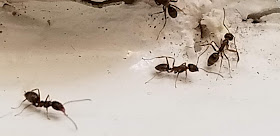Last week
we posted a blog about this dead American dagger moth caterpillar hanging on a small redbud tree. Kevin Firth identified it and said "According to Wagner, the culprit is
Aleiodes stigmator, a
Braconid wasp." This was in February and yet the caterpillar's body was hard and firmly attached to the branch. Ordinarily a Braconid wasp parasitizing a caterpillar turns it into a squishy mass once the parasitoids have grown up and escaped. There is one genus of parasitic wasps which leave a stiff caterpillar case, the
Aleiodes sp. called the Eastern mummy wasps
.
Charley Eiseman* describes their unusual behavior. "Most parasitoid
Braconid wasp larvae live in the caterpillar until they chew their way out and form pupa on the outside of the skin. The caterpillar usually survives for a few days and in the case of one species, the caterpillar actually guards the pupa, vigorously wiggling to drive off any predators until it finally dies. However, the
Aleiodes sp. larva pupate
inside of the caterpillar!"
Most Eastern mummy wasps,
Aleiodes sp., tend to be solitary, one per caterpillar. The exception to this rule is
Aleiodes stigmator which is a gregarious parasitoid. It specializes in large hairy caterpillars and may have as many as 40 larvae in a single caterpillar. Eiseman says* "When mature they puncture the caterpillars underside to leak fluids, they dry and firmly attach it to the substrate. The caterpillar becomes hardened and mummified.
A. stigmator chews evenly spaced exit holes on the top."

Bingo! Our hairy caterpillar was attached firmly to the redbud twig all winter. Once I pried it off, I could see the neat round exit holes all along the back. I handled it gently at first but after photographing it I found that the body was hard. It didn't break under pressure and resisted cutting with thin surgical scissors. By pupating inside the hardened mummy they are protected from many predators. Once the mummy was open, there wasn't anything to see except the holes.
 |
| Ventral Surface - Yellow=drain hole for body fluids, red= spiracle for breathing, now dried open |
I brushed off the hairs and could identify 11 exit holes only along the back. This confirmed that the culprit was the gregarious
Aleiodes stigmator. Scott Shaw's bible of
Aleiodes ** says that "It is not unusual for 40-50 wasps to emerge from a single mummy. The emergence holes are evenly spread across the top of the mummy, from front to back, leaving a quite distinct appearance, as though pelted evenly by shotgun pellets." It looks like our caterpillar got off easy.

At the Nature Center's Insectorama kids can take home silk moth caterpillars to raise. Parasitoids emerging from their caterpillar instead of its forming a pupa is initially disappointing but offers a good teaching opportunity. In nature moths and butterflies leave large numbers of eggs to ensure survival of some of their offspring. The surplus of caterpillars feeds the birds, as well as the wasps, and they in turn and in sum prevent the redbud trees from being destroyed by all those hungry caterpillars.
Aleiodes sp. also parasitize several well-known forest pests such as the gypsy moth, eastern tent caterpillar, forest tent caterpillar and fall webworm in addition to more benign tussock moths, dagger moths, prominents, and loopers. This is all part of the web of life that provides for our own survival, and entertainment.***
One last interesting historical tidbit.
Aleiodes stigmator was the first of its genus to be identified.
Thomas Say,
the father of American entomology described it in 1824. He thought
the exit holes looked like the stigmata in the hands and feet of the
Christ, thus the
stigmator name.
*
Tracks and Sign of Insects and other Invertebrates, Charley Eiseman and Noah Charney.
**
Alleiodes Wasps of the Eastern Forests: A Guide to Parasitoids and Associated Moth Caterpillars. Scott Shaw
*** With thanks to Chris Barnhart.


 My specimen was a male with diagnostic "boxing gloves" on the end of its palps. Unlike our version used to batter someone, these are handy if somewhat messy, used by the spider to collect and hold its sperm until transferring them to the female during mating.
My specimen was a male with diagnostic "boxing gloves" on the end of its palps. Unlike our version used to batter someone, these are handy if somewhat messy, used by the spider to collect and hold its sperm until transferring them to the female during mating.













